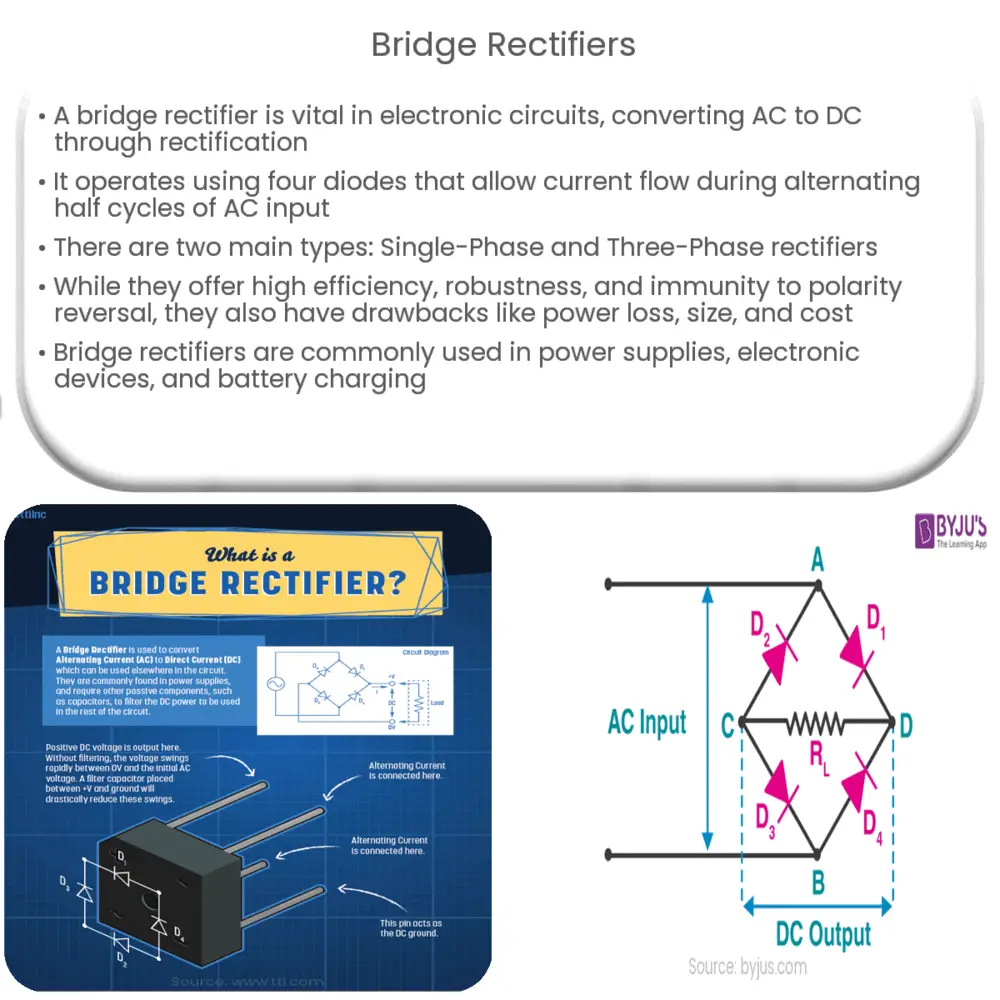Explore the working principles, types, advantages, disadvantages, and applications of bridge rectifiers in our comprehensive guide.

Introduction to Bridge Rectifiers
A bridge rectifier is a critical component in electronic circuits. It is responsible for converting alternating current (AC) to direct current (DC), a process known as rectification. The name ‘bridge rectifier’ originates from its structure, as it essentially forms a bridge using four diodes.
Working Principle of Bridge Rectifiers
Understanding the operation of a bridge rectifier involves appreciating the principles of diodes and their function in electronic circuits. A diode allows current to pass in one direction – from its anode to cathode – and blocks it in the opposite direction.
- Positive Half Cycle: During the positive half cycle of AC input, the upper end of the transformer secondary winding becomes positive. Diodes D1 and D2 will be forward biased, allowing current flow, while D3 and D4 will be reverse biased, blocking current. This condition creates a path for the current, from point A to B in the circuit.
- Negative Half Cycle: In the negative half cycle, the polarity of the AC input is reversed. Now, diodes D3 and D4 are forward biased, and D1 and D2 are reverse biased. This time, current flows from point B to A, maintaining the same direction as in the first half cycle.
Types of Bridge Rectifiers
There are two main types of bridge rectifiers:
- Single-Phase Bridge Rectifier: The most common and simplest form, it uses a single-phase AC supply and four diodes for the rectification process.
- Three-Phase Bridge Rectifier: This type utilizes a three-phase AC supply and six diodes. It is typically used in high-power applications due to its capacity to handle higher currents and voltages.
Advantages of Using a Bridge Rectifier
Bridge rectifiers offer numerous advantages that make them preferred over other types of rectifiers:
- Higher Rectification Efficiency: They convert both halves of the AC cycle into DC, thereby doubling the efficiency compared to half-wave rectifiers.
- Robustness: With their simple structure, bridge rectifiers demonstrate a high degree of robustness and reliability.
- Polarity: They are immune to polarity reversal, making them safe to use in circuits where reverse polarity can cause damage.
Disadvantages of Bridge Rectifiers
Despite their numerous advantages, it is also important to acknowledge some of the drawbacks associated with bridge rectifiers:
- Power Loss: Bridge rectifiers have a relatively higher voltage drop because the current passes through two diodes in each half cycle, leading to increased power loss.
- Size: They are bulkier than other rectifiers due to the use of four diodes, which makes them unsuitable for compact designs.
- Cost: The use of additional components in bridge rectifiers leads to increased cost compared to simpler rectifiers.
Applications of Bridge Rectifiers
Bridge rectifiers have a broad range of applications, including:
- Power Supplies: They are commonly used in power supply circuits to convert AC into DC.
- Electronics Devices: They are used in various electronics devices, such as radios and televisions, to provide the required DC supply.
- Battery Charging: Bridge rectifiers are used in battery charging circuits due to their ability to provide steady DC output.
Conclusion
In conclusion, bridge rectifiers play a critical role in our everyday electronic applications, serving as a crucial bridge between AC and DC power. Their robust structure, higher rectification efficiency, and immunity to polarity reversal make them an ideal choice in many scenarios. Nevertheless, the inherent power loss, size, and cost factors associated with them necessitate careful consideration during their implementation. As technology evolves, more efficient and compact bridge rectifiers are continually being developed, promising an exciting future for this foundational component in electronics.

